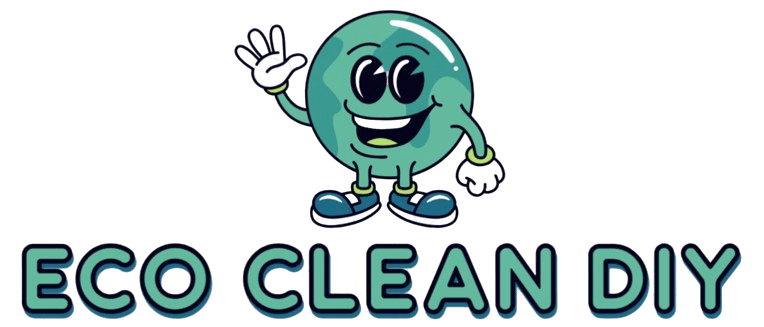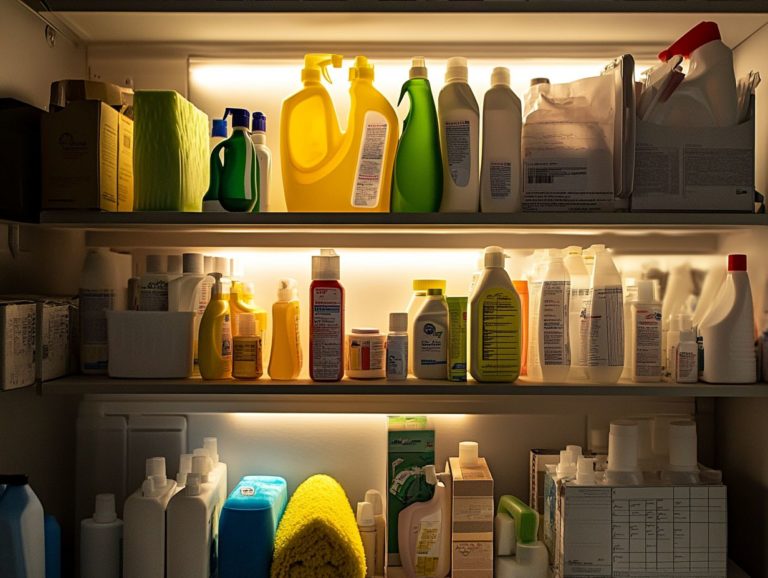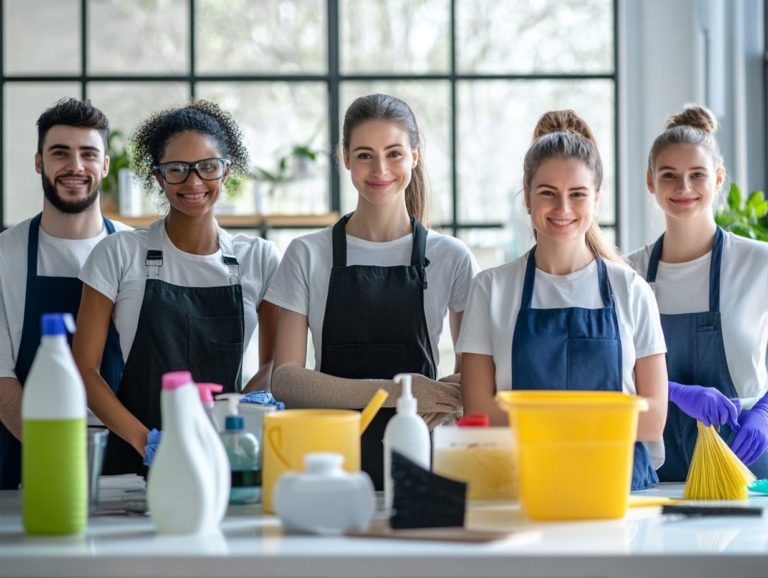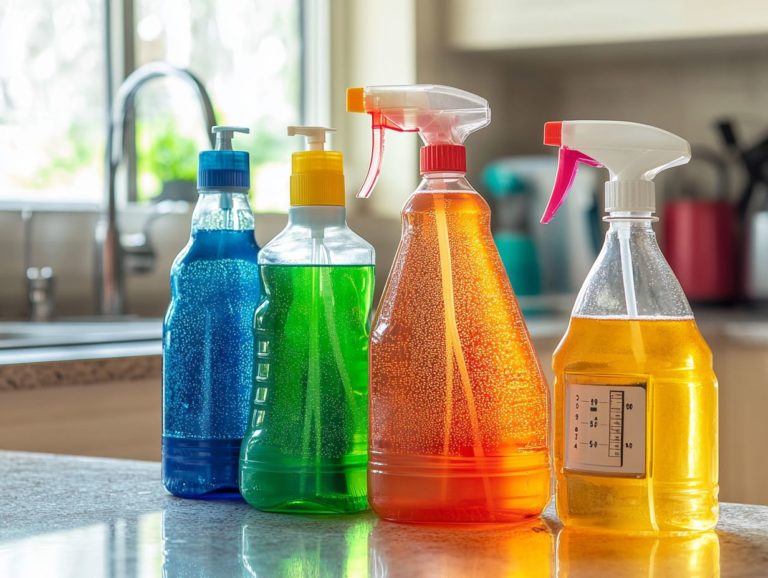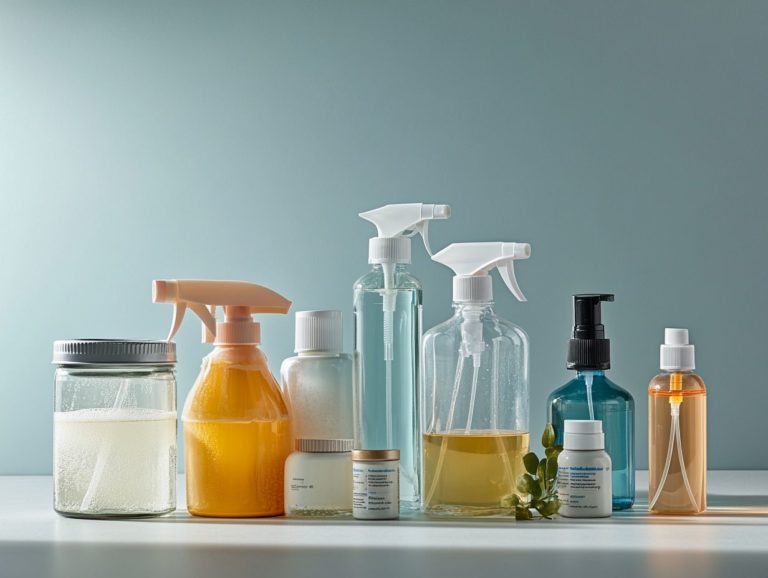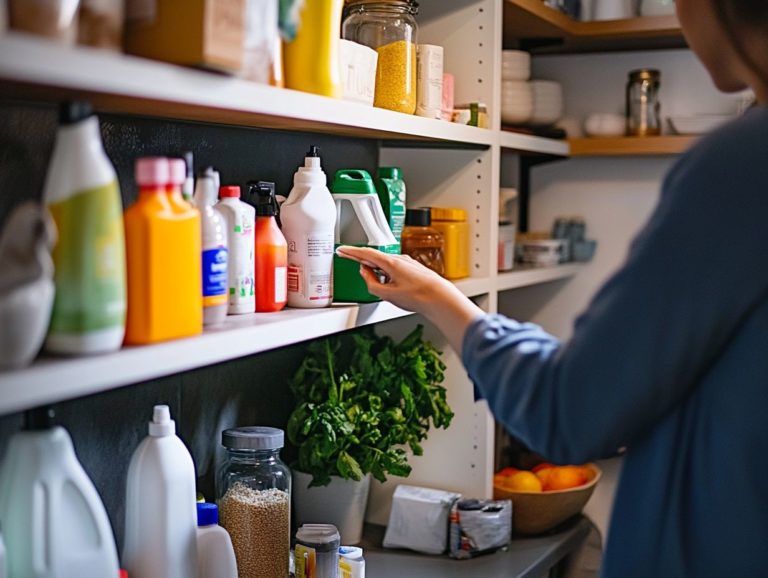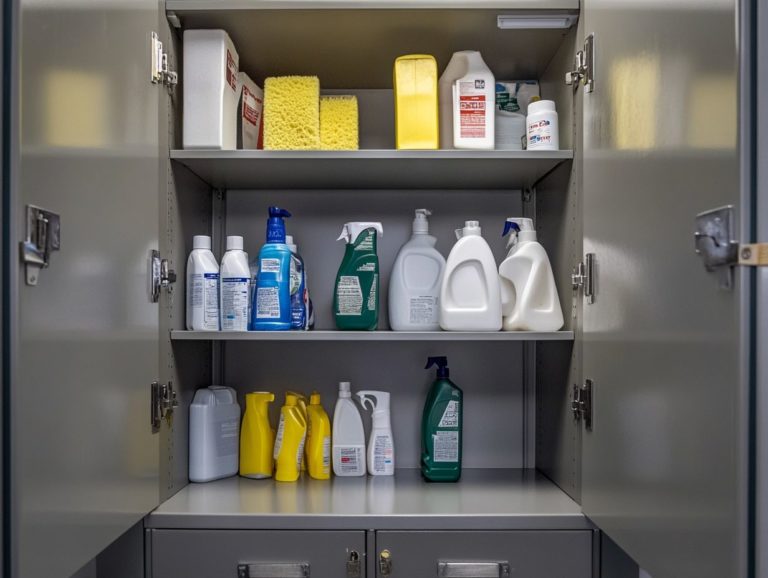How to Protect Your Cleaning Supplies from Damage
Cleaning supplies are vital for maintaining a safe and healthy environment, but they can easily suffer damage or misuse if not handled carefully. It s essential to protect these household cleaning products, as their effectiveness directly impacts safety especially in homes with children and pets.
Let s explore how to protect your cleaning supplies and keep your home safe! This article covers common causes of damage to cleaning supplies and chemicals, best practices for their storage and usage, and tips for safe transportation. Discover the secrets to keeping your cleaning essentials in pristine condition, ensuring they re always ready when you need them most.
Contents
- Key Takeaways:
- Why Is It Important to Protect Your Cleaning Supplies?
- How to Properly Store Your Cleaning Supplies?
- What Are the Best Practices for Using Cleaning Supplies?
- How to Protect Your Cleaning Supplies During Transportation?
- Frequently Asked Questions
- What are some common causes of damage to cleaning supplies?
- How can I protect my cleaning supplies from damage caused by extreme temperatures or other accidental exposures?
- What should I do if my cleaning supplies get wet?
- Is it important to read the labels on cleaning supplies for storage instructions?
- How can I prevent damage to my cleaning supplies while using them?
- What are some tips for proper storage of cleaning supplies?
Key Takeaways:
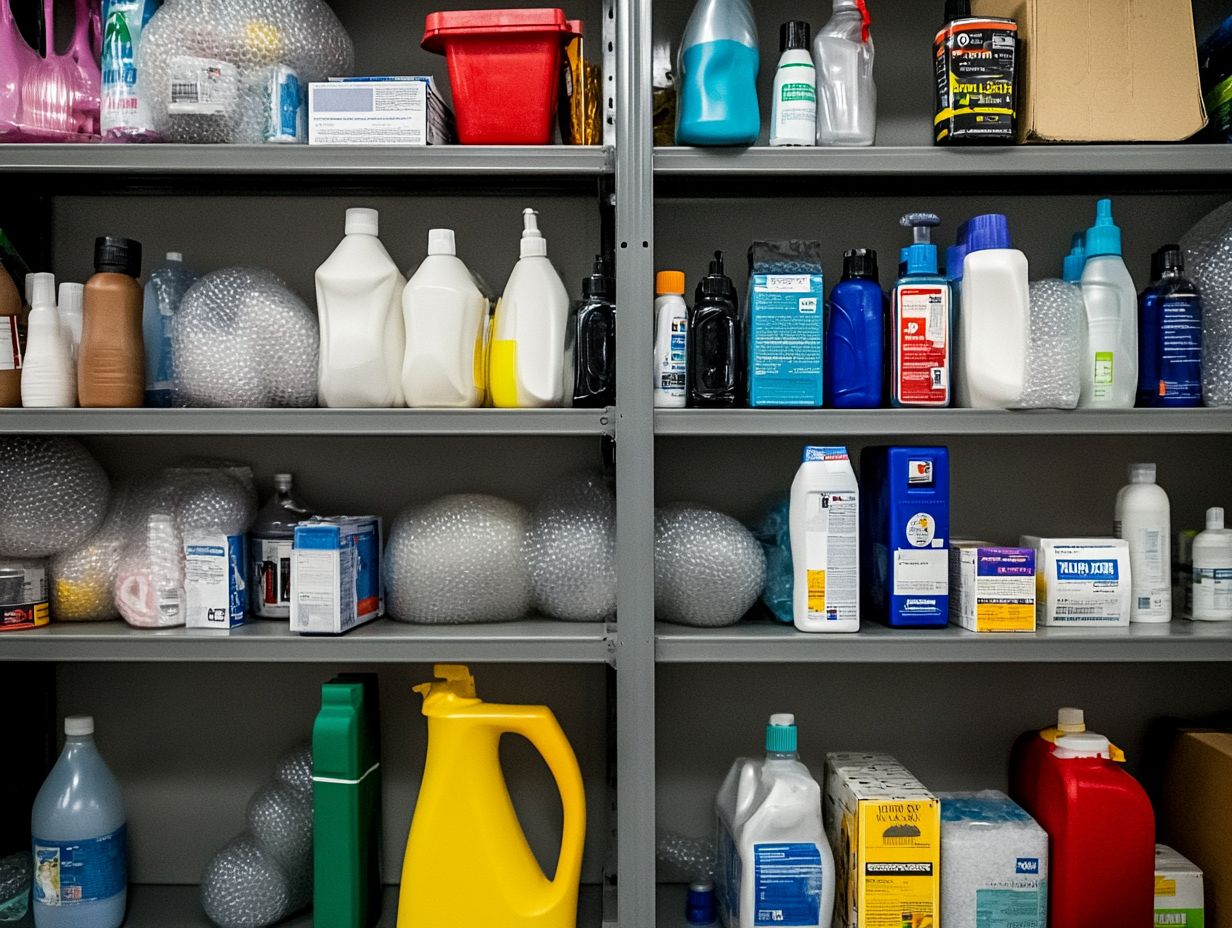
- Properly store your cleaning supplies in their original containers in a cool, dry place to prevent damage.
- Always read and follow instructions, wear protective gear, and properly dilute and dispose of cleaning products.
- When transporting cleaning supplies, use appropriate packaging, seal containers tightly, label clearly, and avoid extreme temperatures.
Why Is It Important to Protect Your Cleaning Supplies?
Protecting your cleaning supplies is crucial, not just for preserving the integrity of your household products but also for ensuring the safety of your home environment. By using safe methods when cleaning and following instructions from organizations like the American Cleaning Institute, you can significantly reduce risks.
Act now to safeguard your cleaning solutions and protect your loved ones from potential hazards! By taking steps to protect these products, such as following proper storage and cleaning practices, you minimize the risk of accidental exposure to hazardous chemicals, which can lead to serious health issues, especially for children and pets.
The American Cleaning Institute emphasizes the importance of proper storage and following safety guidelines to prevent misuse and accidents, ultimately creating a healthier living space for you and your loved ones. The National Capital Poison Center also offers helpful resources and the Poison Help Line for emergencies.
What Are the Common Causes of Cleaning Supply Damage?
Common causes of cleaning supply damage often stem from improper handling, exposure to extreme temperatures, and inadequate storage practices. These factors can compromise the effectiveness of your cleaning solutions, including liquid laundry packets, and following chemical safety protocols can help mitigate these risks.
These issues can significantly impact the performance of your cleaning supplies, leading to less-than-stellar results when tackling tough stains or disinfecting surfaces. For example, high humidity or direct sunlight can change how effective your cleaning solutions are, reducing their cleaning power. This is particularly important for sensitive products like environmental cleaning products designed to be sustainable.
Careless handling like dropping bottles or failing to securely close lids can lead to leaks or spills, wasting valuable products and creating potential safety hazards. By understanding these risks and conducting routine safety checks, you can maintain your supplies effectively and ensure that you achieve maximum efficacy in your cleaning tasks.
How to Properly Store Your Cleaning Supplies?
Proper storage of your cleaning supplies is essential for preserving their effectiveness and ensuring safety in your home. By adopting smart storage techniques, you can significantly reduce the risks associated with hazardous chemicals while extending the lifespan of your cleaning products, including nontoxic disinfectants and those recommended by organizations like Midlab.
Regularly reviewing the safety data sheets documents that provide safety information about cleaning products and conducting routine safety inspections of your household cleaners will further enhance safety. An organized approach to storing your products not only prevents accidents but also promotes a more efficient cleaning routine, making your tasks feel less like chores and more like a breeze. This approach aligns with best practices recommended by cleaning professionals like Better Life Maids.
Start organizing your cleaning supplies today to ensure a safer home for you and your family!
1. Keep Them in Their Original Containers
Keeping your cleaning products in their original containers is crucial for maintaining their effectiveness and ensuring safety.
These containers usually come equipped with important labels that provide essential information about any hazardous chemicals lurking in those cleaning solutions. These labels don’t just list ingredients; they also offer clear instructions for safe use, proper storage, and disposal. This information is vital for preventing any unfortunate mishaps.
Original containers often include safety data sheets that outline potential hazards and first-aid measures in case of accidental exposure. Always reference product labels to ensure compliance with NFPA 30 standards.
Without this valuable information, you might accidentally mix incompatible substances, leading to potentially dangerous reactions. By ensuring that your cleaning products stay in their original packaging, you can easily identify potential risks and follow safety protocols, creating a much safer environment at home or in the workplace.
2. Store in a Cool, Dry Place
Storing your cleaning supplies in a cool, dry place is essential for maintaining their effectiveness, especially for household products that can lose potency when exposed to excessive heat or humidity.
The importance of optimal temperature and humidity levels cannot be overstated; many cleaning agents contain main ingredients that may diminish over time. For example, bleach should be kept at room temperature and shielded from sunlight, while aerosol sprays need to be stored in a cool environment to mitigate the risk of explosion.
Consider suitable storage locations such as a temperature-controlled pantry or a designated cabinet in a climate-regulated garage. These options help protect your products from environmental fluctuations.
By ensuring proper storage for your cleaning supplies, you can significantly extend their shelf life, guaranteeing efficient cleaning results whenever you need them.
3. Keep Out of Reach of Children and Pets
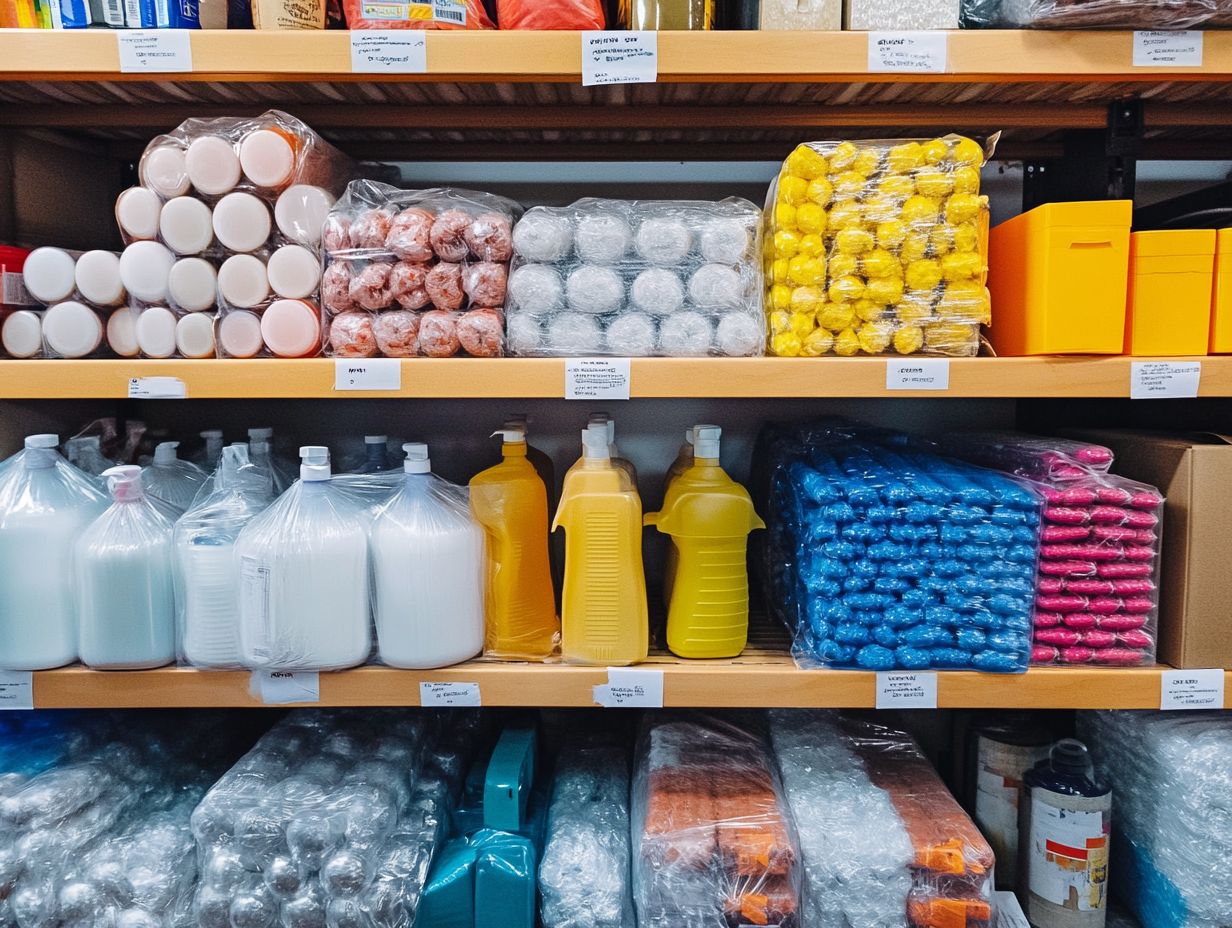
It is imperative to keep cleaning products out of reach of children and pets to prevent accidental exposures that could lead to serious health issues. This highlights the necessity of implementing effective safety tips in your cleaning routines.
Use high cabinets or locked storage bins to keep them safe! Also, recognize the importance of personal protective equipment (PPE), like gloves and masks during your cleaning tasks.
When handling these products, wearing gloves, masks, and goggles significantly reduces the risk of skin irritation and respiratory issues that can arise from chemical exposure. This is particularly important in settings like hospitals where cleaning staff must follow stringent cleaning protocols to prevent the spread of infections like C. difficile.
Make sure your cleaning supplies are clearly labeled and stored in their original containers for proper identification, minimizing the chances of accidental misuse. By prioritizing these safety measures, you can create a cleaner environment while safeguarding the health of your loved ones. It s also wise to keep the Poison Help Line number readily accessible in case of emergencies.
Take immediate action to protect your home by following these essential safety tips!
4. Separate Chemicals and Non-Chemicals
Separating cleaning chemicals from non-chemical products is an essential practice that safeguards against unwanted chemical reactions and ensures the safe use of various cleaning solutions, including nontoxic disinfectants. For example, facilities like the St. Louis Wheel ensure strict separation of cleaning chemicals to avoid hazardous spills and toxic fumes.
This separation becomes even more crucial in environments such as kitchens or hospitals, where the presence of specific chemical substances could trigger harmful interactions, leading to toxic fumes or hazardous spills. The importance of this practice goes beyond just safety; it also significantly boosts the effectiveness of your cleaning protocols.
By thoughtfully organizing your cleaning supplies, you can steer clear of the pitfalls that come with mixing incompatible products, which not only undermines cleaning efficiency but also puts the health of everyone using those products at risk. This approach is integral to sustainable cleaning and maintaining a healthier environment.
Effective cleaning hinges on a well-considered strategy that harmonizes safety with operational effectiveness, ultimately cultivating a healthier environment for all. Cleaning carts equipped with clearly labeled compartments for different types of supplies can aid in this effort.
What Are the Best Practices for Using Cleaning Supplies?
Implementing best practices for using cleaning supplies is crucial not just for achieving effective cleaning results but also for safeguarding everyone involved in the process. By adopting safe cleaning techniques, utilizing cleaning solutions efficiently, and donning personal protective equipment (PPE), you can significantly minimize the risks tied to cleaning products. Following guidelines from organizations like the American Cleaning Institute and conducting routine safety checks will further enhance your cleaning protocols.
Furthermore, adhering to proper cleaning procedures and embracing environmental cleaning principles will help you cultivate a safer and healthier home environment.
1. Read and Follow Instructions
Reading and adhering to the instructions on cleaning supplies is essential for achieving effective cleaning while minimizing the risk of accidents that can arise from various cleaning solutions. Always ensure you follow the detailed labels and reference materials like the safety data sheet for each product.
Many users tend to overlook the detailed labels that offer crucial guidance on how to properly dilute, mix, or apply these products, which can inadvertently lead to subpar results or even hazardous situations. Consider the dangers: mixing bleach with ammonia can produce toxic fumes that pose serious health risks. Additionally, neglecting the recommended dwell time the duration a cleaner should sit on a surface can inhibit effective germ-killing, allowing harmful pathogens to persist. This is particularly critical in healthcare settings where environmental cleaning is paramount.
It s worth noting that certain cleaning agents are specifically formulated for particular surfaces, and misapplying them can lead to damage, resulting in costly repairs. Therefore, by understanding and respecting these guidelines, you not only ensure safe usage but also significantly enhance the effectiveness of your cleaning routines.
2. Wear Protective Gear
Wearing personal protective equipment (PPE) while handling cleaning supplies is not just a precaution; it s an essential safety measure that shields you from the hazardous chemicals often lurking in cleaning products.
The significance of proper protective gear, or PPE, cannot be overstated. Even routine cleaning tasks can expose you to harmful substances that may lead to respiratory issues, skin irritation, or even long-term health problems. Among the various types of PPE, gloves, goggles, and face masks are critical in protecting you from chemical splashes and toxic fumes. It’s also essential for household cleaning activities.
Disposable gloves are particularly effective in keeping corrosive agents at bay, while goggles provide vital eye protection during your cleaning duties. By prioritizing the use of appropriate protective measures, you create a significantly safer working environment, dramatically reducing the risk of chemical-related incidents. Furthermore, using personal protective equipment is a fundamental aspect of chemical safety.
3. Properly Dilute Concentrated Products
Properly diluting concentrated cleaning products is crucial for effective cleaning and safety. When you use excessive concentrations, you not only run the risk of health hazards but also diminish the effectiveness of your cleaning solutions.
This aligns with best practices in cleaning protocols. Taking the time to accurately measure and mix these products ensures that surfaces are cleaned thoroughly. It also reduces the risk of chemical burns or respiratory issues that can stem from improper handling.
Implementing such safe cleaning practices helps mitigate potential health problems. For example, many all-purpose cleaners recommend dilution ratios of 1:10 or 1:20, meaning you would mix one part cleaner with ten or twenty parts water, depending on how dirty the surface is.
Always refer to the manufacturer’s instructions for the correct dilution rates. Different products like bleach or disinfectants may require unique approaches. These methods not only enhance hygiene but also prolong the lifespan of various materials, ultimately safeguarding both your health and the environment.
Utilizing sustainable cleaning products can further add to these benefits.
4. Never Mix Chemicals
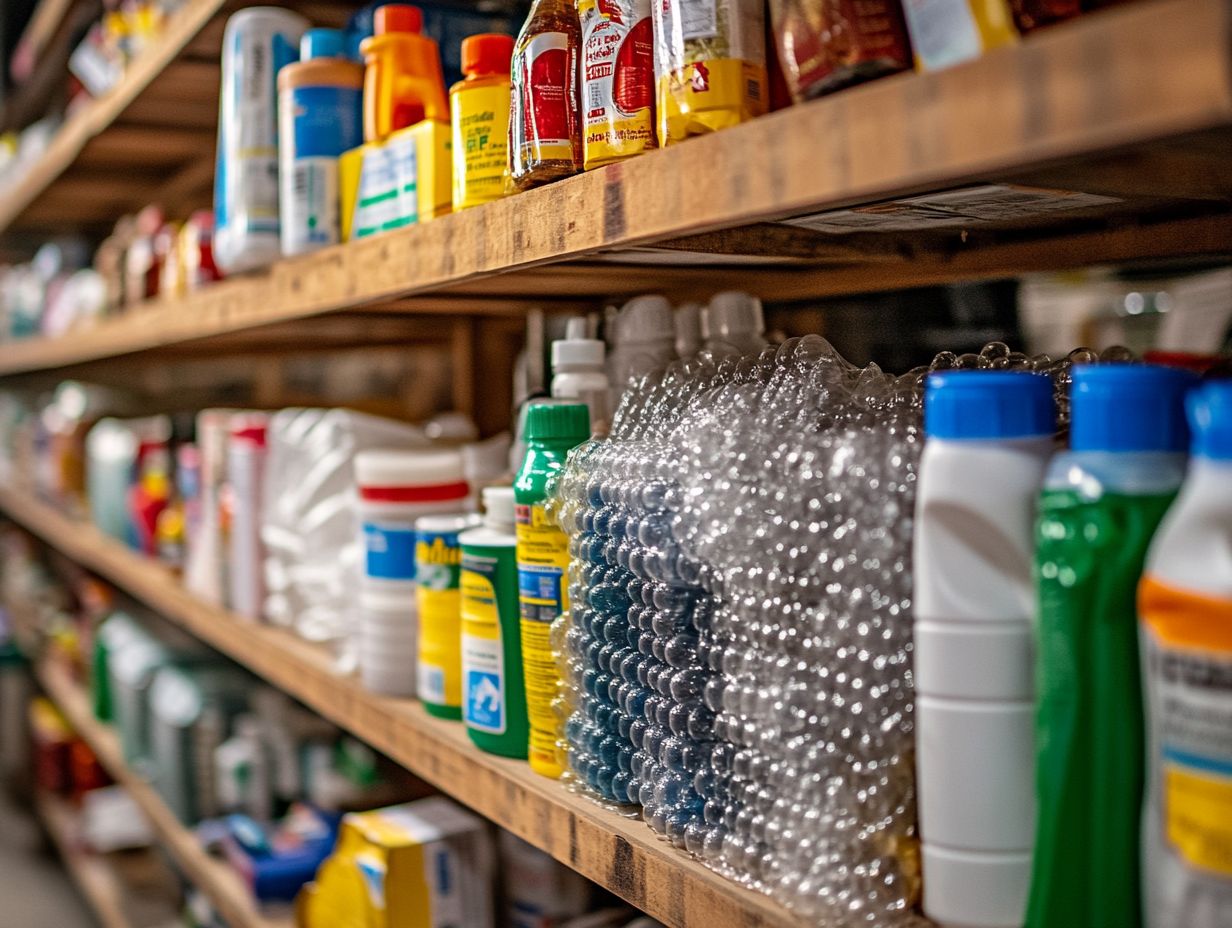
Never mixing cleaning chemicals is a fundamental safety practice. You should prioritize this to prevent dangerous reactions and accidental exposure to dangerous materials.
This is crucial for ensuring safe chemical handling during your cleaning procedures. When you combine two or more cleaners, you run the risk of creating harmful gases or explosive reactions that can pose serious health risks.
For instance, mixing bleach with ammonia releases toxic chloramine vapors, which can lead to respiratory issues and eye irritation. Strong acids and bases can react violently, resulting in caustic splashes that may burn your skin or damage surfaces.
These interactions put you at risk and compromise the safety of your environment. Always adhere to safe chemical handling protocols to mitigate these risks.
To maintain a safe cleaning routine, it s essential to thoroughly read labels and understand the ingredients you are using. Consider referring to the American Cleaning Institute for guidelines on household cleaners and nontoxic disinfectants.
5. Dispose of Unused Products Properly
Proper disposal of unused or expired cleaning products is crucial for maintaining environmental integrity. This helps prevent hazardous chemicals from contaminating delicate ecosystems.
Consulting resources like the National Capital Poison Center can provide valuable safety tips. To achieve this, you should familiarize yourself with local regulations regarding the disposal of such materials.
These rules can vary significantly from one community to another. Many areas provide designated collection days or drop-off locations specifically for hazardous household waste, making it easier for you to dispose of unwanted items responsibly.
Opting for eco-friendly alternatives, such as recycling containers or choosing biodegradable cleaning agents, can significantly reduce your ecological footprint. This approach ensures compliance with safety regulations and allows you to contribute to a cleaner, healthier environment for future generations.
Consider using environmental cleaning products endorsed by organizations like Better Life Maids for sustainable choices. Act now! Dispose of your cleaning products correctly to protect our planet!
How to Protect Your Cleaning Supplies During Transportation?
Protecting your cleaning supplies during transportation is vital. This maintains their effectiveness and safety, particularly when utilizing cleaning carts or transferring them between locations.
Companies like Midlab and Better Life Maids offer products designed to withstand transit hazards. Implementing proper storage practices, such as secure packaging and clear labeling, can help you avoid leaks, spills, and potential accidents.
Refer to NFPA 30 guidelines for comprehensive proper storage techniques. It s essential to adopt safety measures that prioritize the integrity of your cleaning products during transport.
Taking a few minutes to secure your supplies can prevent costly accidents! This grants you peace of mind and ensures the safety of your cleaning staff.
1. Use Appropriate Packaging
Choose the right packaging to avoid dangerous leaks! Your cleaning products deserve the best protection. Using the appropriate packaging for your cleaning supplies is essential for ensuring safe transportation. It minimizes the risk of leaks and protects product labels from damage during transit.
Choosing the right materials is vital. For example, sturdy plastic or glass containers are excellent for effectively containing liquids. Well-constructed cardboard boxes provide additional support. It s also wise to consider including absorbent materials within the packaging to soak up any potential spills.
By ensuring that cleaning products are securely sealed and cushioned, you can maintain their integrity and prevent any shifting during handling. Additionally, keeping your cleaning supplies secure through clear labeling of the packages enhances safety by informing handlers of the contents and any necessary precautions to take.
This attention to detail ultimately contributes to a more efficient and risk-free delivery process, allowing you to transport your products with confidence. Always ensure product labels include all necessary hazard warnings and handling instructions.
2. Securely Seal Containers
Securing containers of cleaning products is crucial for ensuring they remain intact and preventing any accidental exposures during transportation, especially when dealing with hazardous chemicals. Routine safety checks can help identify potential issues early.
To achieve comprehensive safety, you must routinely inspect seals for integrity and confirm that they are properly affixed to prevent leaks. Using extra containers to catch spills can significantly lower the risk of leaks. This is especially important when handling liquid laundry packets and other high-risk items.
Using clear hazard labels not only boosts safety but also makes it easy to recognize what’s inside! Regular training for personnel involved in the handling and transport of these materials is essential; it enhances adherence to safety practices, making the entire process more secure and compliant with regulatory standards.
Ensure access to the safety data sheet (a document that provides information on handling chemicals safely) for all cleaning products used.
3. Label Packages Clearly
Start labeling your packages today! This small step can prevent accidents and ensure safe handling. Labeling packages clearly is an essential safety tip that helps you identify cleaning products and their associated hazards during transportation.
Effective labeling practices not only enhance safety by preventing accidents but also promote organization in various settings, such as warehouses, retail stores, and your own home.
For instance, using color-coded labels to indicate the nature of contents like toxic, flammable, or biodegradable allows for quick recognition and proper handling. Follow the clear labeling practices used by companies like Better Life Maids to improve your cleaning procedures.
Including safety symbols along with critical information such as usage instructions and first-aid measures can significantly minimize the risk of mishaps. By prioritizing clear labeling, you can help foster safer practices in your workplace and ensure that everyone, from employees to customers, can navigate their environment with confidence.
This is especially important for environmental cleaning tasks, such as dealing with C. difficile.
4. Avoid Extreme Temperatures
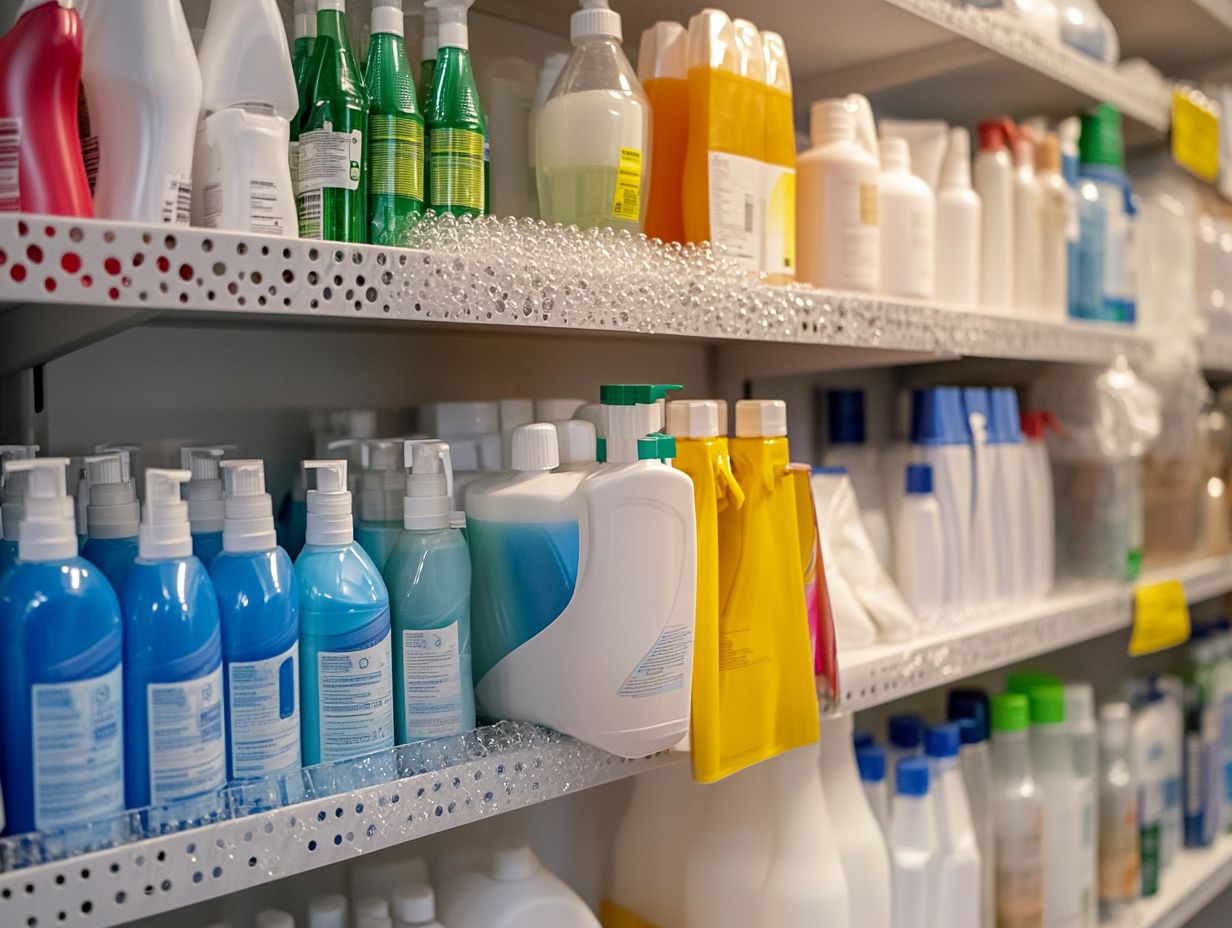
Avoiding extreme temperatures when transporting cleaning supplies is crucial for maintaining their integrity and effectiveness. This ensures that the products remain safe for use, especially for environmental cleaning products that may be sensitive to temperature changes.
Extreme heat can change the chemical makeup of cleaning agents. This can lower their effectiveness or even cause dangerous reactions. Cold temperatures may lead to freezing or separation of some products.
To effectively manage temperature fluctuations, consider using insulated containers or temperature-controlled vehicles during transit.
You should monitor the temperature with thermostats or temperature loggers. This can provide invaluable data, allowing for knowledge-based decision making regarding storage and transport practices. Taking these precautions is essential for keeping your cleaning supplies effective and safe!
This is especially relevant for COVID-19 related cleaning supplies, which may have specific storage requirements.
Frequently Asked Questions
What are some common causes of damage to cleaning supplies?
Exposure to extreme temperatures, moisture, and poor storage are common causes of damage to cleaning supplies.
How can I protect my cleaning supplies from damage caused by extreme temperatures or other accidental exposures?
To protect your cleaning supplies from extreme temperatures, store them in a cool, dry place away from direct sunlight or heat sources. This reduces the chance of accidental exposures that could compromise the functionality of your supplies.
What should I do if my cleaning supplies get wet?
If your cleaning supplies get wet, make sure to dry them thoroughly before storing them. This helps prevent mold or bacteria growth.
Is it important to read the labels on cleaning supplies for storage instructions?
Yes, it is important to read the labels for storage instructions as each product may have specific guidelines to prevent damage.
How can I prevent damage to my cleaning supplies while using them?
To prevent damage while using cleaning supplies, follow the instructions on the label and use the appropriate amount for the task at hand.
What are some tips for proper storage of cleaning supplies?
Proper storage includes keeping cleaning supplies in their original containers, storing them in a dry and cool place, and keeping them out of reach of children and pets. Regular routine safety checks can help ensure compliance with these safety tips.
